Brief

Changes to the complex pipelines that make payments possible rarely occur, but when they do happen, the consequences can be profound. Distributed ledger technology, first showcased by the Bitcoin digital currency network, has the potential for such dramatic change—yet most banks have not adequately prepared for the ensuing battles to retain control of customers and of merchant payment interfaces.
By removing central intermediaries, simplifying connections between counterparties and recording data on a tamper-proof block chain, distributed ledger technology has the potential to improve the speed, transparency and efficiency with which payments are made. Bitcoin, for all its flaws, provides a compelling example of the possibilities, and has catalyzed a surge of investment and innovation. Since 2012, roughly $1 billion in capital has poured into hundreds of distributed-ledger investments. Official recognition has followed: For example, Ripple Labs, a prominent distributed ledger start-up, has secured a seat on the Federal Reserve’s Faster Payments Task Force, the US regulator’s flagship payments modernization effort.
What are the implications for banks? To address that question, Bain & Company interviewed more than 50 senior bankers, venture capitalists, technologists, international payment association executives and start-up CEOs. What became clear from these conversations: While in theory banks are well positioned to confront the changes triggered by the rise of distributed ledgers, in practice the situation is more complicated. Regulatory and other hurdles may have forced most start-ups to partner with, rather than compete against, incumbent banks, but distributed ledgers will create winners and losers within the banking industry.
How distributed ledgers work
Distributed ledgers have a broad variety of uses, but are particularly relevant to payments. Traditional payments systems rely on a central authority and hierarchy to generate trust and transfer value. When money passes between participants, usually in the form of digital entries in a database, a central counterparty records and supervises the transfer to prevent cheating. The participants then undertake costly, time-consuming and duplicative reconciliation with their own systems.
With digital ledgers, however, trust comes from the process itself rather than from the status of any one participant. In this secure, shared database, participants have their own copies of the stored data. Changes in the form of payments get validated by participants collectively and updated across the network almost immediately. Strong cryptography ensures that transactions can be initiated only by certified parties, that there is one version of the truth, and that the outputs of the system are accurate and irrevocable and can be trusted to represent value (see Figure 1).
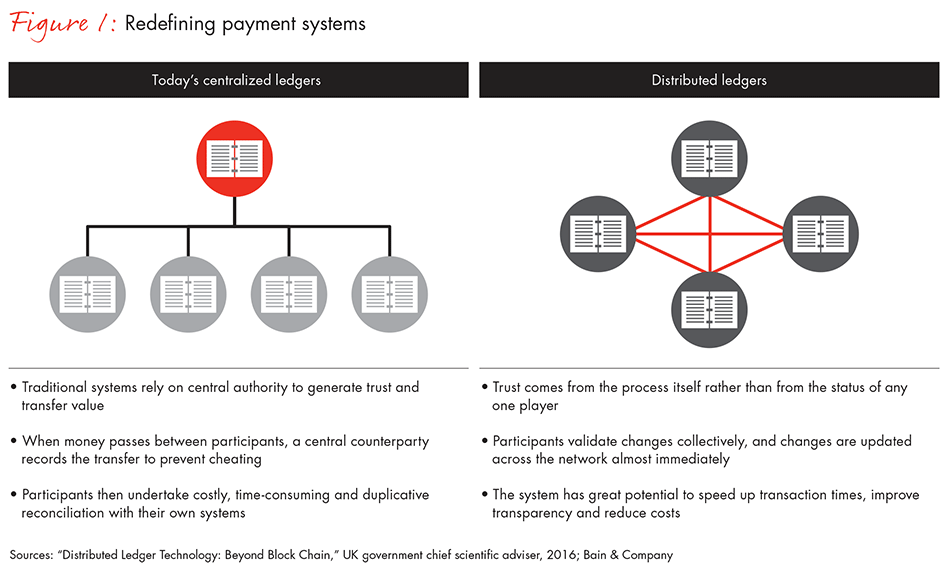
Moreover, distributed ledgers can identify participants and automatically execute transactions, thereby providing a powerful platform to support the advanced functions and business logic known as “smart contracts." For example, in even the most basic distributed ledgers, rules can be established requiring multiple signatures to authorize payments, effectively creating a mechanized escrow arrangement.
Although distributed ledgers are a relatively new phenomenon, they combine a number of established technologies in novel ways:
- The block chain—a secure record of historical transactions, collected into blocks, chained in chronological order and distributed across a number of different servers to create reliable provenance
- Digital signatures—unique digital keys used to authorize and check transactions and positively identify the initiator
- A consensus mechanism—rules and techniques to ensure that participants recording and processing transactions agree on which transactions are valid
- A digital currency—in some implementations, a cryptographic token that represents actual value. Bitcoins are one example, but ultimately central banks could create digital fiat currencies as well.
The precise features of distributed ledgers vary depending on the situation. Some systems, such as Bitcoin, allow any participant to validate transactions, while others, such as Ripple, restrict permissions to a small group of trusted parties. Each choice regarding systems architecture involves trade-offs. For example, Bitcoin’s openness facilitates widespread adoption, but also imposes costs, as it requires a complex, expensive and energy-wasting consensus mechanism to prevent fraud.
A surge in two waves
The spread of distributed ledgers likely will not be linear. Instead, we expect development to follow two distinct waves:
- Wave 1: development of specific systems focused on international payments
- Wave 2: broader disruption of domestic payments triggered by central-bank-supported digital fiat currencies
In the first wave, financial institutions will focus on situations with clear opportunities for improvement, tangible rewards for innovators and where no central counterparty (such as a global central bank) dominates. In that context, the most promising starting points lie in international payments services, particularly correspondent banking and trade finance (see Figure 2). Replete with obvious friction points and anachronisms—international payments can take days to settle, lack transparency and regularly fail altogether due to messaging errors—companies have ample motivation to upgrade these services. By contrast, domestic payments systems, such as credit cards and automated clearing houses, generally function effectively, and thus lack a strong business case or customer demand for change.
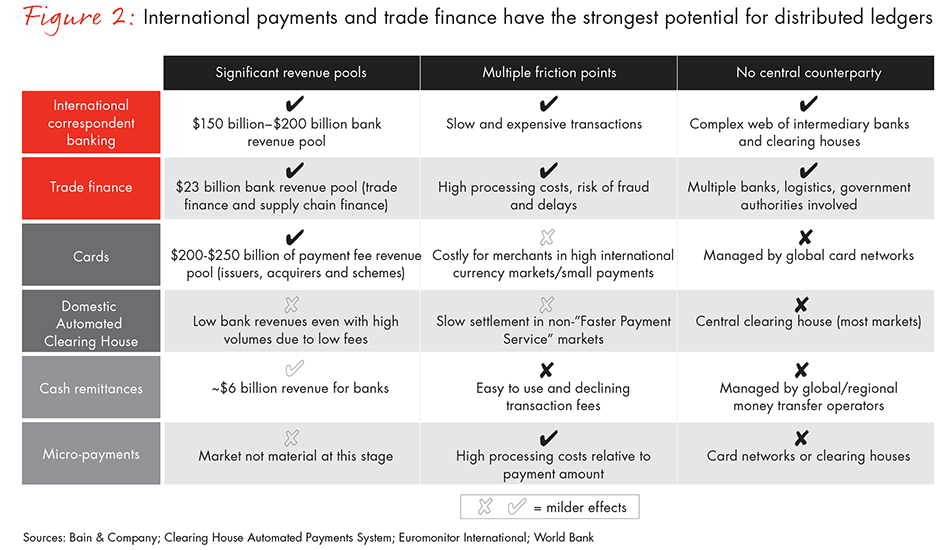
Piecemeal development will eventually give way to broad disruption. The contours of this second wave are already emerging, as several central banks have started to examine the idea of issuing national digital currencies under different scenarios. Should central banks choose the most extensive implementation and make true digital money available to all (rather than just a mechanism for banks to transact among themselves), the effect on the domestic banking sector would be broad and deep. Retail banks stand to lose their privileged position with customers and face much greater competition for funding and for lending products. Ultimately, the credit card and automated clearing house industries risk annihilation.
Cutting through the tangle of international correspondent banking
Without an agreed central intermediary to coordinate things, international financial institutions have developed a workaround for their customers. Banks hold bilateral (or correspondent) relationships with one another, and clear and settle transactions directly. If two banks lack a direct relationship, they use other banks as intermediaries to complete the connection, adding to the complexity (see Figure 3).
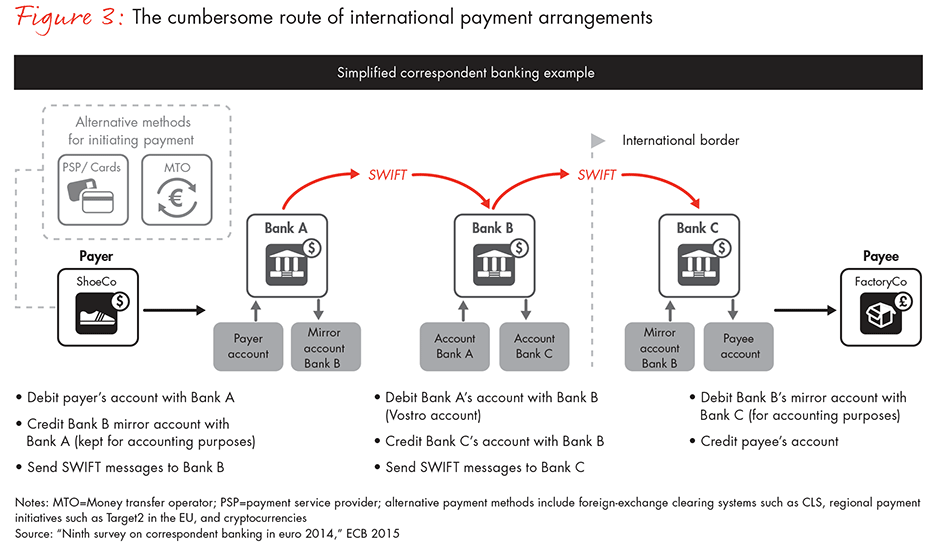
Compared with the current system, digital ledgers offer distinct advantages. By cutting the number of middlemen and enabling direct transactions between counterparties, digital ledger solutions speed up transaction times. They also ensure that each participant has a complete view of its customer accounts and balances—the key building blocks of automated payment-tracking and notification tools. Such improvements would go a long way to meet customer demands for a more responsive, holistic view of their financial positions.
Digital ledgers could significantly reduce costs and error rates. For example, banks currently must pre-fund multiple settlement accounts, whereas distributed ledger transactions settle almost immediately and reduce those liquidity costs. Even foreign-exchange costs might be trimmed, because greater transparency on foreign-exchange margins would likely spur more price-based competition.
Change will not come easily to international correspondent banking. The current market structure gives incumbent companies a powerful incentive to preserve the status quo. We estimate that about $300 trillion of transactions flow through international correspondent banking networks each year, generating $150 billion to $200 billion in revenues for banks. Network dynamics make alternative systems hard to scale up: Participants will not join a network until it has sufficient reach, but reach comes only from widespread participation.
Perhaps the best-known company trying to solve this problem, the San Francisco–based start-up Ripple, has built a functioning system for international payments around a bespoke protocol and currency. Since 2012, Ripple has raised almost $40 million in venture capital and is working with about 30 banks to run pilot tests of its software in different use cases. Yet financial institutions remain hesitant, due to concerns about the scalability of the technology, privacy issues associated with broadcasting commercially sensitive information about money flows, and the volatility and governance of the bridge currency (see Figure 4).
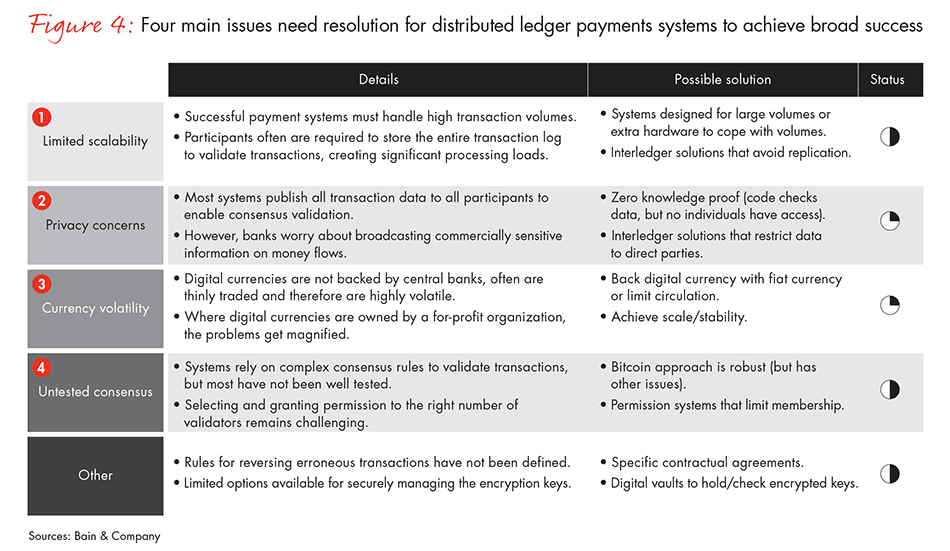
Still, we see evidence that companies will overcome these technical and adoption hurdles. The wave of investment in Bitcoin and related start-ups clearly signals that payments channels are attracting a new degree of interest. With focus comes change, and the system is already in flux. New competitors are nibbling at the edges of international payments, thereby changing customers’ expectations. In consumer markets, companies such as TransferWise use existing technologies to offer improved services to customers, and corporate customers have taken notice. According to recent surveys by the Association of Financial Professionals and Temenos, about 60% of corporate treasurers are dissatisfied with the payment services provided by their banks and have been reviewing those products.
Hard choices for banks
How should banks react to these fast-moving developments? Their current approaches to experimentation—appointing mid-level technology executives to industry consortia, participating in the conference circuit and running limited distributed ledger simulations—may leave banks flat-footed. "Wait and see" makes sense only when coupled with a clear-eyed strategic plan that identifies specific actions to take should certain trigger points occur. Without such a plan, banks risk postponing key decisions until it is too late to respond effectively. Different types of banks should consider tailored strategies.
For super-regional banks, in multiple countries and with global aspirations, digital ledgers offer a practical means to compete with global transaction banks by replicating their networks at lower cost and with a far stronger proposition for customers. Partner selection will be crucial. Add too few participants and the network will not be compelling for customers; too many, and achieving agreement becomes impossible. Super-regionals should therefore focus on building relationships with a few natural allies whose geographical coverage complements their own.
Still, super-regionals will need to lay the groundwork for more-complex alliances and initiatives. One option is to focus on specific products—say, interbank payment transfers or cash pooling—that can be developed quickly, internally and at low cost as a way to build confidence, experience and momentum within the organization.
For global powerhouses, the largest global transaction banks, the outlook is mixed. If they do nothing, they stand to lose as new competitors enter the market. But if they can overcome institutional inertia, they can draw on their scale, trusted relationships and IT expertise to secure and improve the efficiency of their current networks. How these banks deploy their resources will determine the outcome (see below, "How Santander Is Testing the Waters.") Pragmatic steps entail encouraging exclusive partnerships with the most promising third-party platforms, developing systems internally, lobbying regulators to maintain the tight antimoney-laundering (AML) and know-your-customer (KYC) regulations that give incumbents an advantage over new entrants, and carefully building the credibility of distributed ledgers by migrating a portion of their existing payment flows to new platforms.
Trade finance: a tougher nut to crack
Trade finance, although a smaller sector than international correspondent banking, exhibits many of the same characteristics. It generates roughly $23 billion of direct banking revenues worldwide, supports many broader transaction banking relationships and suffers from extensive frictions. For example, about 50% of banks’ cost for a letter of credit arises from manual document handling and checking, which creates delays, errors and expense. That opens the door to huge potential improvements from digital ledgers, although commercial offerings capitalizing on that potential are still in early stages. Moreover, trade finance is particularly suited to distributed ledger solutions because it involves commitments from unrelated parties subject to very different legal regimes and cultural norms. Embedding trade deals within automated business logic, to produce smart contracts, creates a common understanding of the mechanics of a deal and makes it easier to enforce the subsequent transactions.
Improvements fall into two categories. First, immediate improvements to the current paper-based trade finance system, including better fraud prevention through digital identification and tracking of paper documents. Second, digital ledger automation that will speed up settlement and reduce costs by mechanizing the messages that confirm receipt of goods and release of payment. In this phase, the more sophisticated elements of digital ledgers, namely smart contracts, will streamline transaction flows. These contracts or business protocols could automatically trigger payments when the parties meet certain conditions, such as delivery of goods, removing the uncertainties that give rise to lawyers and judges interpreting contract clauses.
If anything, change in the world of trade finance likely will proceed more slowly than for international correspondent banking. Past efforts to create global standards have failed even when supported by major industry participants, suggesting that no one bank, however large, can bring to bear enough influence to shift existing behaviors. For example, Bolero (a European Union–initiated project) and the digital letter of credit system known as Bank Payment Obligation (BPO) have gained only limited adoption despite their high-profile backers. But pressures are mounting on both trade finance and international correspondent banking, and banks cannot afford to ignore the issue. Once again, banks will need to adopt different strategies according to their size and ambitions.
For super-regionals, digital ledgers offers the potential to establish a beachhead in a market currently dominated by global powerhouses. To achieve that goal, super-regionals should focus on the trade corridors where they already have a footprint and can exert influence on the supply chain. Super-regionals should collaborate with a handful of like-minded partners, including other banks, shipping and logistics companies and local customs and port authorities, in order to quickly solve technical issues and get into production mode, so that they can build credibility and experience before expanding their offer to additional participants.
Global powerhouses have substantial costs and risks associated with outdated manual processes in trade finance. To improve margins and provide superior customer service, global powerhouses will need to learn from previous failures. They should focus on customers with the scale to move the trade finance ecosystem and the business profile to justify the effort. Sectors such as textiles and commodities, where global companies have been integrating their supply chains with sophisticated technology platforms and margins are razor thin, could provide fertile ground for new ways of working.
Domestic payments, just over the horizon
While domestic payment systems function effectively in most developed countries, there is great potential for disruption in the long run. Central banks, including the People’s Bank of China and the Bank of England, are energetically exploring the idea of issuing a national digital currency based on digital ledgers. The attractions for central banks and governments include more direct control over the execution of monetary policy, better tracking of financial payments and the potential for automated tax collection.
The devil, of course, lies in the details. Restricted to interbank deals, effectively replacing real-time gross settlement systems such as CHAPS in the UK, a digital fiat currency would have limited impact. Made available to the public and packaged with low-cost payment services, however, it could radically change the financial services sector. If consumers and businesses could exchange electronic payments without requiring cards or an ACH system, the rationale for, and importance of, current (checking) accounts diminish. In turn, banks’ key hook product, from which banks make higher-margin cross-sales, becomes problematic. Banks thus could find themselves in greater competition for both deposits and lending volumes (see Figure 5).
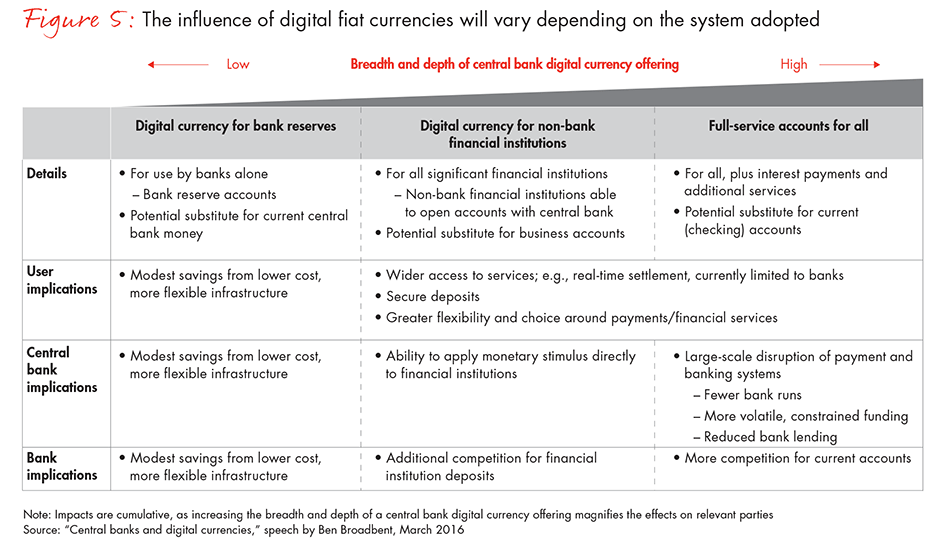
Central banks will no doubt proceed with caution. Commercial banks may have the option to accelerate the pace, though, by creating their own private digital currency, either in a consortium or independently. For example, a commercial bank digital pound, backed one-for-one by sterling and operating as a form of cash, would allow the consumers and businesses that bank with the institution to transact directly among themselves. If successful, central banks would likely follow suit—perhaps mirroring the development of paper bank notes, once printed by each bank individually and subsequently harmonized by central banks.
Whatever the specific trigger or development trajectory, digital currencies stand to amplify trends already reshaping the industry. New European regulation such as the Directive on Payment Services (PSD2) is set to break the banks’ hold on customer data, while payments wallets produced by Apple, Google and other technology firms threaten banks’ unique relationship with their customers. To cope with such uncertainty, banks should identify and pursue actions and options that will prepare them both for short-term dislocation and the eventual arrival of digital currency. (See the Bain Brief "A Strategy for Thriving in Uncertainty.") Three broad, mutually reinforcing, areas for action stand out.
Accelerate investment in digital wallets and payment apps. Banks today profit from a privileged position with the consumer. They provide free current accounts that give customers access to basic financial services—safekeeping funds, payment options and so on. In return, banks receive a cheap source of funding, a platform for cross-selling and the data crucial to pricing risk and credit. Digital wallets such as Apple Pay and PayPal are slowly eroding that position, and digital fiat currencies will accelerate the process. To combat the threat and maintain their unique access to the customer, banks should invest rapidly and urgently in new payment apps and wallets.
Reframe regulatory compliance as a crucial source of competitive advantage. If central banks do move to issue digital fiat currencies, they will likely insist on knowing who owns the wallets in which they will be stored (unlike Bitcoin, where wallet ownership is anonymous). This requires KYC processes, which commercial banks handle in the existing financial system. Many banks perceive compliance with AML and KYC regulations as a costly distraction. But in fact, compliance forms a substantial barrier for new entrants, and as such is a strategic asset that greatly benefits banks.
Invest in start-ups and services related to securing digital identities. In any scenario, digital keys and strong cryptography likely will play a greater role. Banks should leverage their status as trusted, regulated entities to become the custodians of those customer encryption keys or digital signatures. That would reinforce their position as the first point of call for consumers looking for secure access to financial services. Banks should invest in technical services to protect customers’ digital signatures, such as digital vaults for cryptographic keys.
Questions to inform next steps
The advent of distributed ledgers presents banking executives with intriguing choices. They must predict the impact and evolution of a nascent, rapidly changing technology on the complex payments industry, forecast likely competitor actions and then adroitly steer large institutions in new directions—all while limiting risk and meeting regulatory requirements. Given those challenges, settling for the status quo would be understandable. However, the innovation genie has popped out of the bottle and doing nothing no longer is a viable option.
As banking leaders move beyond experimentation to act, they can start by answering a set of fundamental questions:
- How prepared is our organization for the growth of digital ledgers and related technologies?
- Which systems should we be concerned about and invest in? Which customers and peers should we work with, and on what terms, to explore, develop and promote digital ledgers?
- Is our strategy to be an innovator or a fast follower? How well do we understand the technology and its commercial implications?
- What is our stance toward wallets? Toward retaining control of customer payment interfaces and customer identities? How robust is our plan to win the battle for customer wallets and digital identities?
Such questions provide a key litmus test. Banks that can succinctly and compellingly answer these questions stand to benefit from new streams of revenues and deeper relationships with clients.
How Santander Is Testing the Waters
For the past few years, Santander has been actively exploring the possibilities of distributed ledgers, including an investment in Ripple. Current projects cover a range of short-term and long-term situations within payments and related fields.
For international payments, Santander recently announced one of the first retail-oriented Ripple-based payments applications for consumers, and it is examining various cash-management products aimed at small and midsize businesses and larger corporate clients. It also engaged in partnerships with other banks, various consortia and technology providers to develop smart contracts for application in trade finance.
At the same time, Santander is working on more speculative opportunities. These include tools to simplify and improve settlement systems in wholesale banking, as well as various approaches to solve the settlement finality, or cash-on-ledger, problem.
When developing a distributed ledger strategy, Julio Faura, head of R&D at Santander, notes the importance of momentum. To overcome inertia and demonstrate results, he says, executives must quickly identify relevant and manageable situations, then get to work. "If you start laying out the whole plan and try to convince everyone at the same time, nothing is going to happen," Faura says. "The key is to start small and keep growing... develop a cheap, functional demonstration, show the advantages and use them to move the organization."
Glen Williams is a partner in Bain & Company’s Customer Strategy & Marketing practice, and leads Bain’s global payments capability. David Gunn is a partner in Bain’s Financial Services practice and coordinates the payments team in Europe, the Middle East and Africa. Eduardo Roma is a partner and Bharat Bansal is a principal in the Financial Services practice. They are all based in London.




